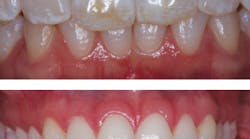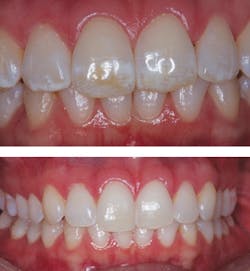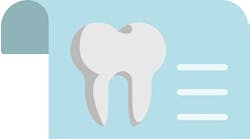As time passes, our clinical team gets accustomed to mundane routines that bring a sense of boredom and fatigue from the deathly spiral of repetition. They lose focus and concentration; they lose the excitement they once had for their work and slowly lose passion. I challenge you to empower your team to support you in a way that allows them to engage "hands-on" in patient therapy. Encourage your team to grow and become more educated, and I guarantee they will have a greater sense of reward and gratification in having the ability to change the lives of their patients.
Sometimes we forget to include and engage our teams with the care of our patients. I think it's time to introduce you to a technology that makes complete sense when it comes to patient care and developing a team that embraces patient therapy.
The vast majority of us will likely laugh at the next statement because I am about to tell you to invest in a suck-down machine. Wait, not just any suck-down machine, but one that really sucks! The machine that I am going to recommend falls into the thermoplastic equipment category and is a positive-pressure machine rather than a vacuum-forming machine. Laugh all you want, but my team generates SIGNIFICANT profit from helping me deliver removable-appliance therapy that rivals the quality of most labs.
Consider this. Few of us have realized that although a CDT is behind the lab that we prescribe our work to, the actual person who fabricates the prosthetics may indeed be less qualified (at least on a resume) than your dental auxiliaries. The reason the lab you use is successful is that the CDT whom you believe is making your patient appliance has done a phenomenal job in educating and training a team member to develop his/her skill set that provides the beautiful end product that you are willing to send out for. Remember, they are provided education and training, and they provide them with the right equipment and materials. YOU CAN DO THE SAME THING!I know what you are thinking, but first you have to admit that your vacuum-forming unit does not adapt materials to models with extreme accuracy. Vacuum-forming is limited due to lack of power and difficulty in removing the air around models that readily trap air. The heating is generally inconsistent and the hardware often lacks the power to adapt to a poorly trimmed model.
Let me introduce you to the MiniStar from Great Lakes Orthodontics. Likely, this is the same unit that your lab uses to fabricate your appliances currently. A positive-pressure machine, like Great Lakes Orthodontics' MiniStar, provides exquisite detail since it forces the material onto the model, capturing the finest of anatomical details such as the sulcus and embrasure spaces. The machine is quick – I mean quick! Only one second to reach working temperature. It's ultra quiet, extremely accurate, and built like a tank. The list of available material options is comprehensive and exhausting. I wish other manufacturers would study the MiniStar when designing equipment as I honestly think this machine has the best opportunity to last through my practicing lifetime.
Also, think about how much control you have when it is sent out … NONE! If your practice provides a poor quality impression, your lab will certainly laugh at you and take pictures of your impression and post them on Facebook, but you will never know! They will make the appliance to the best of their ability, let you know they did the best they could, and have you spend significant chair time grinding down the supposed "customized" appliance your patient is expecting to fit like a glove.
Your journey of providing amazing care does not start with hiring an elite lab, for even the best labs cannot make magic happen when you provide inaccurate records. Let the magic start with your team. Give them some responsibility and have them directly involved in patient care.
The MiniStar has truly been a shining star for my practice. The equipment, array of materials, support, and training have allowed my team to embrace and completely manage removable-appliance therapy in my practice. It's helped them to become more educated on clinical treatment planning, improve their manual dexterity, understand material science, and explore the fabrication of multiple appliances for my patients. From a clinical perspective, my patients are far better off because my team is more educated to advise patients on removable-appliance therapy. From a business standpoint, without diving into my personal numbers, I had a positive ROI after three months of integration. After three months of use, my team is now managing our "removable-appliance lab" and takes pride in fabricating the following products:
- Professional-grade athletic mouthguards with custom logos
- Occlusal guards of any design (including dual laminate)
- Anterior deprogrammers
- TMJ/TMD orthotics and splints
- Temporary matrices
- Indirect bonding trays
- Orthodontic positioners
- Bleaching and fluoride trays
- Invisible orthodontic retainers
- Clear orthodontic appliances for minor tooth movement
- Hawley appliances
- Expansion appliances
- OSA titration appliances
- Model duplication materials
- Custom trays
I need you to dig deep into your records and calculate some stats on appliance therapy from your practice. How many different appliances do you offer? What is the cost to your practice for the fabrication of these appliances (i.e., chair time, impression cost, seat time, and lab fee)? What about situations when your patient finally decides to move forward with the crown that you've recommended fixing for the past five years, but they decide that they want it done several months after delivering an appliance? I know the feeling. It hits you in the stomach, because like any good doctor, you have your lab make a new appliance and eat the bill since you get to do a crown. This scenario completely changes when you own and control the lab!
When your team takes on the privilege and responsibility of fabricating removable appliances, they will likely pay more attention to the quality of their impressions. They will pay more attention to sequencing of treatment and advise patients accordingly since they will take pride in fabricating the appliance and will not want to remake it. It's empowering for your team to have a sense of involvement in patient care. What would be the impact to your practice if you have more control in quality, reduce chair time, no lab bill and only material costs, and most importantly, a team that embraces appliances as an integral part of your treatment since they manage the appliance fabrication completely? Honestly, it's priceless!
____________________________
More by Dr. Neal Patel:
____________________________
Neal Patel, DDS, created a completely digital practice where he utilizes digital technology throughout (all-digital planning, fabrication of splints, surgical guides, and prosthetics), bypassing traditional analog methods. Widely published, he is best known as an international educator on 3D digital imaging, treatment planning, and computer-guided implant surgery. He can be reached via email at [email protected].
Past DE Articles







